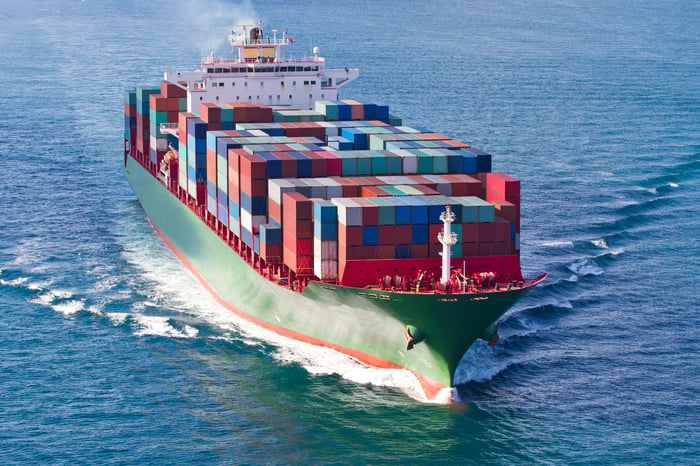According to an article published in the Motley Fool, ExxonMobil one of the largest and most diversified energy companies in the world, with an impressive history of thinking long-term is best prepared to deal with the 2020 chanllenges.
The company is better positioned than many of its peers for the fuel standard change that was implemented on Jan. 1 in the sea shipping industry. Here’s what happened, why Exxon is set to benefit, and what it really says about this energy giant.
Shipping Cleans Up?
Most people are aware of the carbon issues surrounding passenger cars. Light vehicles, however, are the low-hanging fruit in the transportation space — the technology to shift to electrified passenger vehicles is pretty robust. Harder to achieve is the widespread electrification of vehicles that carry heavy loads over long distances. One area that is particularly difficult to “clean up” is sea shipping.

That, however, doesn’t mean that the world is turning a blind eye to the emissions of ships. It just means that the improvements will be incremental, and likely slow. For example, in 2018 the United Nations’ International Maritime Organization (IMO) announced that, starting in 2020, sea ships would need to upgrade their fuels. The rule, known as IMO 2020, requires a shift from 3.5% sulfur fuels to 0.5% fuels, with the goal of reducing the emissions inherent in using carbon-based fuels. It isn’t the final goal to clean sea shipping, just a step along the path. But for the shipping industry it is still a big change.
Strategies To Clean UP
There are multiple ways for a shipping company to reduce its pollution footprint and comply with the mandate. For example, some shippers have installed scrubbers on their ships to clean up their emissions. That will allow them to keep using older, cheaper fuels. However, the longer-term trend is going to be for increased demand for fuels that meet the IMO 2020 standard. At least for a few years, and perhaps much longer, such fuels are likely to be priced at a premium to older blends.
Exxon Updraging Assets
Exxon, meanwhile, is a big part of this puzzle because it has one of the largest and most regionally diverse refining portfolios in the world. And it is one of the best positioned to provide the shipping industry with the clean fuels it needs.
Just having a big refining footprint isn’t enough, since producing lots of the older, dirty fuels isn’t a great long-term plan for dealing with IMO 2020. Exxon has specifically been working to upgrade its portfolio of refining assets, though you might now know it.
- The coverage of the company’s plans to spend up to $35 billion a year through 2025 has largely focused on Exxon’s upstream operations (oil and natural gas drilling).
- But within that spending is also money going toward its downstream businesses (refining and chemicals).
- A specific example of Exxon’s efforts to upgrade its refining portfolio related to IMO 2020 was the late 2018 introduction of cleaner fuel technology at the energy giant’s Antwerp refining facility.
According to the company:
The new 50,000 barrel-per-day unit expands the refinery’s capacity to meet demand for cleaner transportation fuels throughout northwest Europe. The company’s investment in the new coker will also help meet anticipated demand for lower-sulfur fuel oil to comply with new standards to be implemented by the International Maritime Organization in 2020.
In other words, Exxon was moving to prepare for the IMO 2020 rule well before the rule was set to be enacted. But this is really part of a larger trend at Exxon, which is always looking to position itself to produce the highest value products possible. This isn’t environmental largess — Exxon wants to charge as much as it possibly can for the products it produces. Like any business, it wants to have profit margins that are as wide as possible. So, from a business standpoint, IMO 2020 is another opportunity to improve profitability.
Exxon Can Produce Enough Compliant Fuel?
What’s interesting is that Exxon believes it has roughly twice the coking capacity of its closest integrated energy peer. In simple terms, that suggests that Exxon can produce more of the new standard fuel than any other international oil giant. Antwerp was an effort to strengthen its lead here. As sea shippers increasingly look to buy cleaner fuels, Exxon will be there to provide it — and reap the benefits of a higher margin product.
Other Developments in Exxon
To be fair, there is a lot more going on at Exxon today than IMO 2020. But this is another example of how the oil giant’s long-term thinking benefits shareholders. Meanwhile, on the oil front, Exxon’s spending has started to bear fruit, with production beginning to turn higher after a few years of modest declines. And that’s largely on the strength of just one of its big drilling projects. While some might argue that falling production is a sign of poor business decisions, the alternate view is that Exxon has chosen to invest during an industry downturn so it comes out the other side a stronger company. In other words, it is acting counter-cyclically, putting money to work when it will get the most bang for its buck. A strong balance sheet, with financial debt to equity at a very low 0.15 times or so, and a historically high 4.9% yield both add to the allure here.
The IMO 2020 example
As the sea shippers increasingly look to buy the cleaner fuels mandated by IMO 2020, Exxon will be there to sell it. And it appears to be better positioned than any of its peers to produce these cleaner fuels. That’s good news, of course, but the bigger takeaway here is that IMO 2020 is an example of the thinking that underpins Exxon’s investment plans. Management is conservative and takes a long-term view, with the goal of creating a portfolio of high value products that will support wide margins. IMO 2020 is really just one more reason why dividend investors looking for an energy stock should take a close look at Exxon today.
Did you subscribe to our daily newsletter?
It’s Free! Click here to Subscribe!
Source: The Motley Fool
















